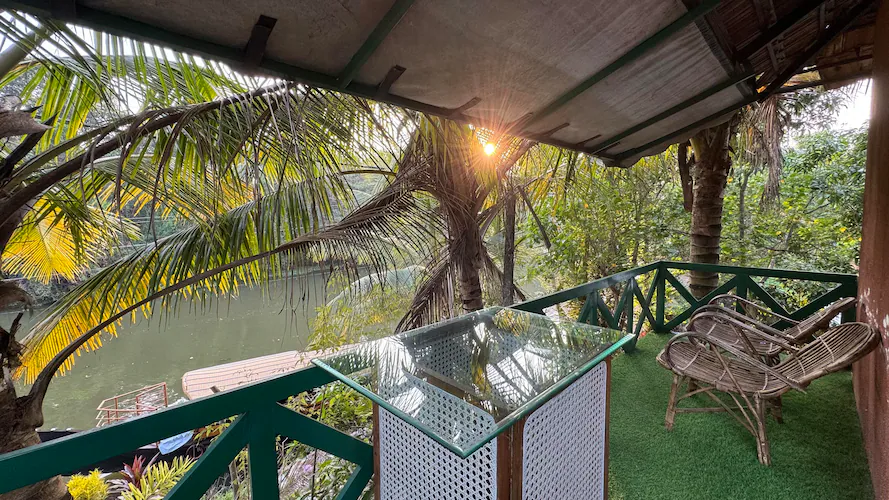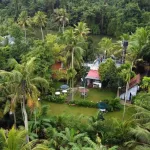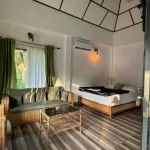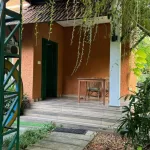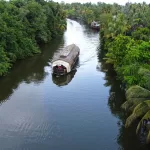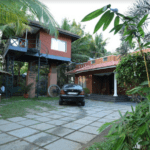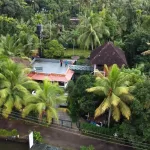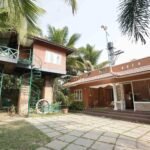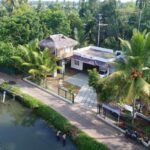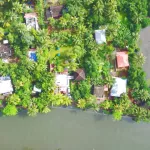Kumarakom is famed for its mesmerizing backwaters and bird sanctuary, but there’s a quieter, less-trodden side to this Kerala gem waiting to be uncovered. From Garggi Kumarakom Homestay, a cozy retreat nestled along the serene waterways, you’re perfectly positioned to venture beyond the houseboats and into the heart of local life. Here, ancient temples whisper history, bustling markets hum with color, and artisan workshops reveal Kerala’s timeless crafts. These hidden gems offer an authentic slice of Kumarakom, far from the usual tourist trails. Let’s explore some of these treasures, complete with directions and insider tips to make your journey unforgettable.
1. Vellavali Temple – A Spiritual Retreat
Tucked away amid paddy fields and coconut groves, the Vellavali Temple is a serene Hindu shrine dedicated to Lord Krishna. Unlike the grander temples of Kerala, this modest sanctuary exudes a peaceful charm, its traditional architecture featuring sloping roofs and intricate wood carvings. Locals believe the temple’s idol has miraculous powers, and its annual festival (usually in February or March—check locally for 2025 dates) draws villagers in vibrant processions.
- Directions: From Garggi Kumarakom Homestay, head northwest along the main Kumarakom road (Kumarakom-Kavanattinkara Road) for about 2.5 kilometers. Turn left at the small junction near the Vellavali bus stop—look for a narrow lane flanked by banana trees. The temple is a 5-minute walk down this path, roughly 10–15 minutes total from the homestay by auto-rickshaw or bike (available for rent from Garggi’s hosts).
- Insider Tip: Visit at sunrise (around 6:00 AM) to catch the morning aarti—oil lamps flicker, bells chime, and the air fills with the scent of jasmine offerings. Bring a small token like flowers or coconut (available at nearby stalls) to join the locals in prayer. Photography is allowed outside, but ask permission before snapping inside.
2. Kumarakom Local Market – A Sensory Delight
Forget the polished souvenir shops—Kumarakom’s local market, near the village center, is where the real pulse of the community beats. This daily bazaar brims with fresh catches from Vembanad Lake—karimeen (pearl spot fish), prawns, and crabs—alongside mounds of spices, handwoven mats, and toddy (fermented coconut sap). It’s a chaotic, colorful affair, perfect for immersing yourself in Kerala’s everyday life.
- Directions: From Garggi, travel east along the Kumarakom road for about 1.5 kilometers toward the village hub (ask your hosts for the exact turn-off, as signage is minimal). The market is near the Kumarakom boat jetty, a 5–10-minute auto-rickshaw ride or a 20-minute walk if you’re up for a scenic stroll along the canal.
- Insider Tip: Arrive by 8:00 AM when the fish sellers are at their liveliest—bargaining is expected, so brush up on your Malayalam phrases (or a smile works too). Try a glass of fresh toddy from a vendor (around INR 20–30); it’s sweet if unfermented, mildly buzz-inducing if aged a day. Pair it with a hot kappa (tapioca) snack from a nearby stall for a true local breakfast.
3. Coir-Making Workshops – Crafting Kerala’s Heritage
Kumarakom’s artisans have long turned coconut husks into gold—coir, the versatile fiber used for mats, ropes, and more. Small family-run workshops dot the village, offering a glimpse into this sustainable craft passed down through generations. These off-the-beaten-path spots let you watch (or even try) the process—from soaking husks to spinning them into threads on traditional looms.
- Directions: Head south from Garggi along the canal-side path for about 2 kilometers until you reach Cheepunkal, a quieter hamlet. Ask locals for “coir units” (pronounced “koy-yer”); one reliable spot is near the Cheepunkal jetty, about 15 minutes by bike or auto-rickshaw. Garggi’s hosts can arrange a visit if you ask in advance.
- Insider Tip: Visit mid-morning (9:00–11:00 AM) when artisans are most active. Bring a small gift like sweets (INR 50–100 worth from the market) to thank your hosts—they might let you spin the wheel or weave a mini mat to keep. Wear comfy shoes; the workshops are often muddy from the husk-soaking pits.
4. St. John’s Jacobite Syrian Church – A Historical Haven
Perched on a gentle hillock, this lesser-known church in Kumarakom dates back centuries, its whitewashed walls and red-tiled roof a testament to Kerala’s Syrian Christian heritage. Inside, faded frescoes and carved wooden altars hint at its past, while the surrounding graveyard offers a quiet spot to reflect. It’s a peaceful detour from the water-centric attractions.
- Directions: From Garggi, take the Kumarakom road north for 3 kilometers toward Kavanattinkara, then veer right at the fork near the school. The church is about 500 meters down this lane, a 15-minute auto-rickshaw ride or a 30-minute walk with views of paddy fields en route.
- Insider Tip: Visit on a Sunday morning (services around 8:00 AM) to hear hymns in Malayalam and see the congregation in traditional attire—women in white sarees with gold borders, men in mundus. The church is open daily, but mornings are quietest for exploration. Respect the sanctity by dressing modestly (shoulders and knees covered).
5. Pottery Workshops in Aymanam – Clay and Creativity
Just across the Meenachil River from Kumarakom lies Aymanam, a village immortalized in Arundhati Roy’s *The God of Small Things*. Here, potters shape red clay into pots, lamps, and figurines, their wheels spinning in open-air sheds. These workshops are a hidden gem, blending art with the earthy scent of wet soil.
- Directions: From Garggi, head east to the Kumarakom jetty (1.5 km), then take a 10-minute ferry across Vembanad Lake to Aymanam (INR 20–30, runs hourly—check with Garggi’s hosts). From the Aymanam jetty, it’s a 1-kilometer walk or a quick auto-rickshaw ride (INR 50) to the pottery cluster near the village center.
- Insider Tip: Go in the late afternoon (3:00–5:00 PM) when the heat dips and potters are finishing their day’s work—they’re more likely to chat or let you try the wheel. Buy a small clay lamp (INR 50–100) as a memento; light it with oil back at Garggi for a cozy evening vibe.
Why Garggi Kumarakom Homestay?
Garggi is more than a place to sleep—it’s your launchpad to these hidden treasures. Its waterfront location keeps you close to the backwaters’ allure, while its warm hosts act as local guides, sharing tips and arranging transport (auto-rickshaws or bikes, INR 100–200 per trip). After a day of exploration, return to unwind with a home-cooked Kerala meal—perhaps fish curry and appam—served on the veranda as the sun dips below the horizon.
- Getting Around: Rent a bicycle from Garggi (ask your host; INR 100–150/day) for a leisurely pace, or hire an auto-rickshaw for convenience. Roads are narrow and signage sparse, so a local map app (like Google Maps) or a quick chat with your host ensures you don’t miss a turn.
- Best Time: March 25, 2025, falls just post-monsoon—expect lush greenery and pleasant weather (25–30°C), though mornings and evenings are coolest for outdoor adventures.
Beyond the backwaters, Kumarakom reveals a tapestry of culture and craft, faith and flavor. From Garggi Kumarakom Homestay, these lesser-known attractions beckon with the promise of discovery—quiet moments in a temple, the buzz of a market, or the tactile joy of clay and coir. Step off the beaten path, and let Kumarakom’s hidden gems weave their magic around you.

